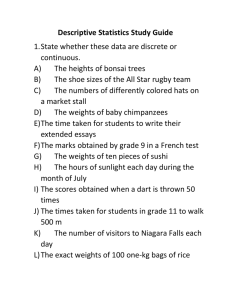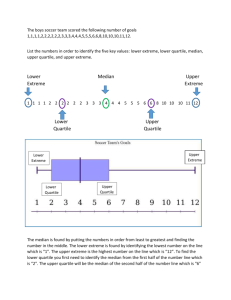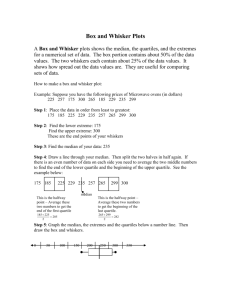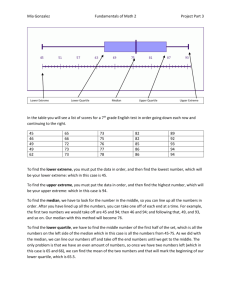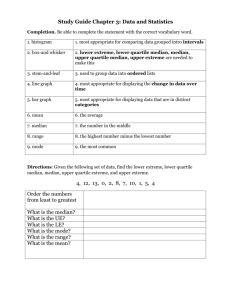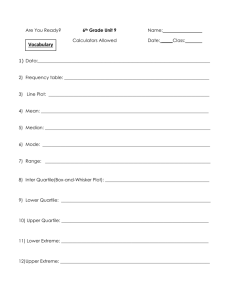Study Guide
advertisement
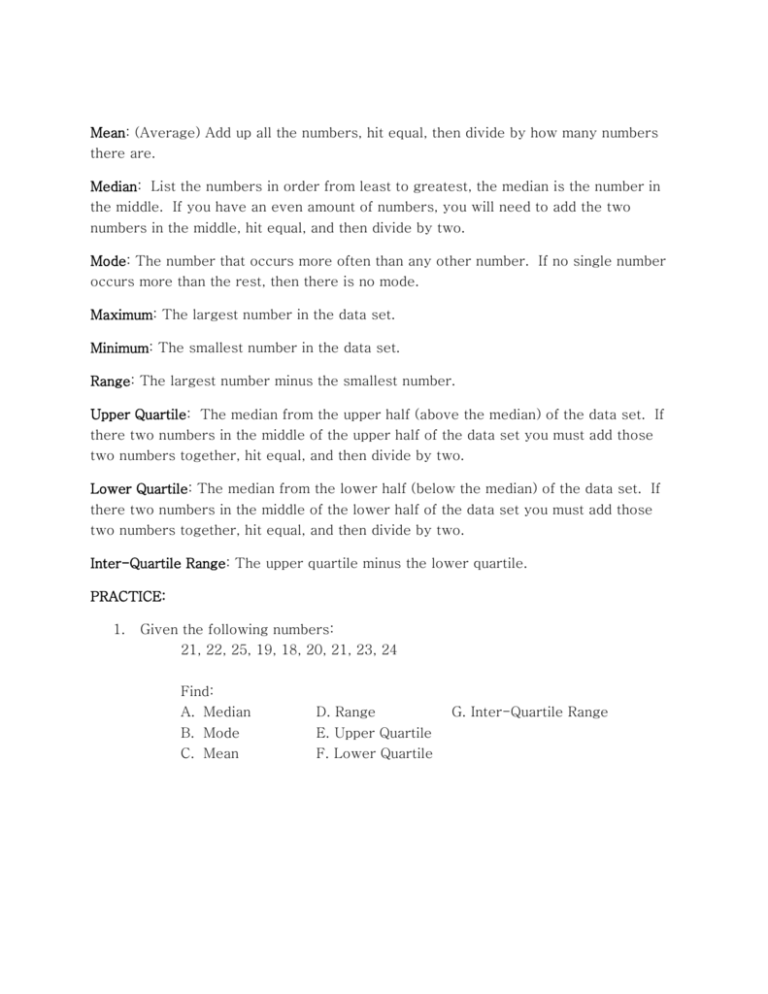
Mean: (Average) Add up all the numbers, hit equal, then divide by how many numbers there are. Median: List the numbers in order from least to greatest, the median is the number in the middle. If you have an even amount of numbers, you will need to add the two numbers in the middle, hit equal, and then divide by two. Mode: The number that occurs more often than any other number. If no single number occurs more than the rest, then there is no mode. Maximum: The largest number in the data set. Minimum: The smallest number in the data set. Range: The largest number minus the smallest number. Upper Quartile: The median from the upper half (above the median) of the data set. If there two numbers in the middle of the upper half of the data set you must add those two numbers together, hit equal, and then divide by two. Lower Quartile: The median from the lower half (below the median) of the data set. If there two numbers in the middle of the lower half of the data set you must add those two numbers together, hit equal, and then divide by two. Inter-Quartile Range: The upper quartile minus the lower quartile. PRACTICE: 1. Given the following numbers: 21, 22, 25, 19, 18, 20, 21, 23, 24 Find: A. Median B. Mode C. Mean D. Range E. Upper Quartile F. Lower Quartile G. Inter-Quartile Range 2. Given the following numbers: 101, 99, 102, 103, 104, 105, 99, 101 3. Find: A. Median D. Range B. Mode C. Mean E. Upper Quartile F. Lower Quartile G. Inter-Quartile Range Given the Stem-and-Leaf Plot below: Stem 0 1 2 Leaf 1, 1, 1, 2, 3, 2, 2, 3, 4, 0, 1, 1, 2, Find: A. Median B. Mode C. Mean 4. D. Range E. Upper Quartile F. Lower Quartile G. Inter-Quartile Range Given the Stem-and-Leaf Plot below: Stem 6 7 Leaf 4, 4, 5, 5, 6, 0, 1, 1, 2 ,4 Find: A. Median B. Mode C. Mean D. Range E. Upper Quartile F. Lower Quartile G. Inter-Quartile Range 5. Given the Box-and-Whisker Plot below: Find: A. Median B. Minimum C. Maximum D. Upper Quartile E. Lower Quartile F. Inter-Quartile Range 6. Joey has 2 red balloons, 3 purple balloons, 5 blue balloons, and 1 yellow balloon. A. What is the probability of Joey randomly selecting a yellow balloon? B. What is the probability of Joey randomly selecting a blue balloon? C. What is the probability of Joey not selecting a purple balloon? 7. Lisa is rolling a number cube with sides 1-6. A. What is the probability of Lisa rolling an even number? B. What is the probability of Lisa rolling a number greater than 2? C. What is the probability of Lisa not rolling a factor of 6? 8. Jim is choosing an outfit for a dance. He has three pairs of pants: Brown, Black, or Blue. He also has five shirts: Red Green, Yellow, or Black. A. What is the probability that Jim will choose brown pants and a yellow shirt? B. What is the probability that Jim will choose black pants and a green shirt? 9. Tom is rolling a number cube 1-6 and selecting a color: Yellow, Green, Pink, or Blue. A. What is the probability of Tom rolling a 2 and picking green? B. What is the probability of Tom rolling a number less than 4 and picking pink? C. What is the probability of Tom rolling a multiple of 2 and picking blue? 10. Jessica is picking a piece of candy out of a bag. There are 12 Snickers, 5 KitKats, 4 Milky Ways, and 2 Hersheys. A. What is the probability of Jessica drawing a Hershey bar? B. If Jessica picks a Hershey and does not replace it, what is the probability of the next student drawing a Hershey bar? 11. John is drawing a marble out of a bag. There are 6 blue, 2 white, 4 green and 4 yellow. A. What is the probability of John picking a blue marble two times in a row if he does not replace the first one? B. What is the probability of John picking a green marble the first time and then picking a yellow marble the second time, if he does not replace the first one? C. What is the probability of John picking a white marble the first time and then picking a yellow marble if he does not replace the first one. 12. Beth is picking a card out of a deck of cards numbered 1-20. Each time she draws a card and then puts it back in the deck. A. Predict how B. Predict how 12 times. C. Predict how D. Predict how times. many times Beth will draw a 5 if she draws 25 times. many times Beth will draw a number greater than 15 if she draws many times Beth will draw a factor of 12 if she draws 32 times. many times Beth will draw an even number if she draws 54



